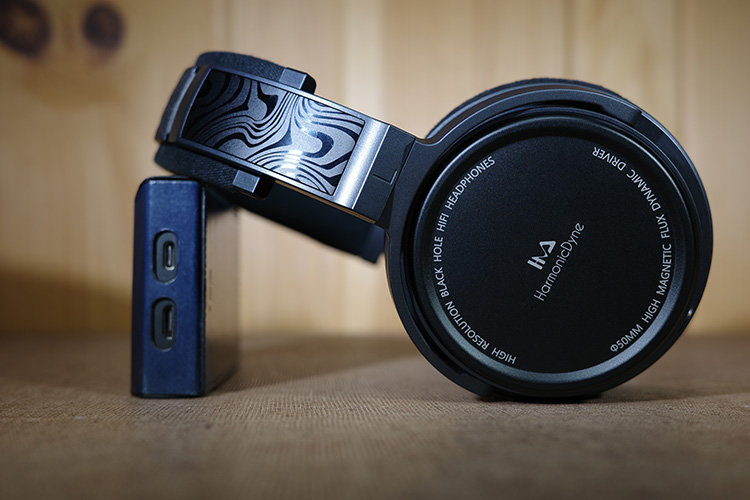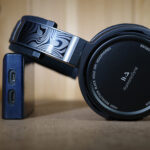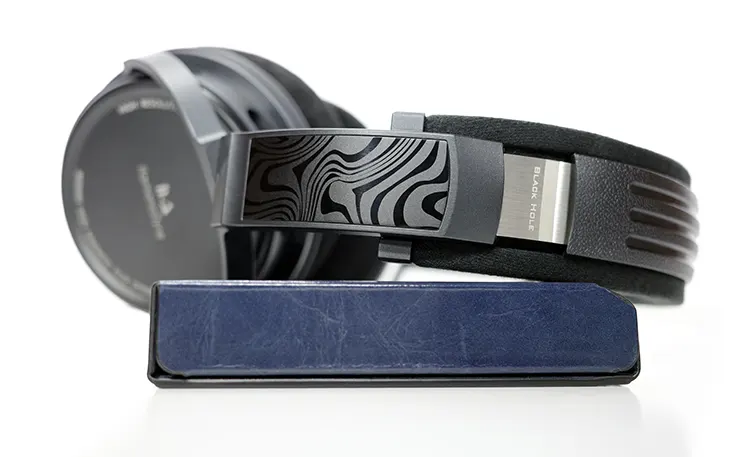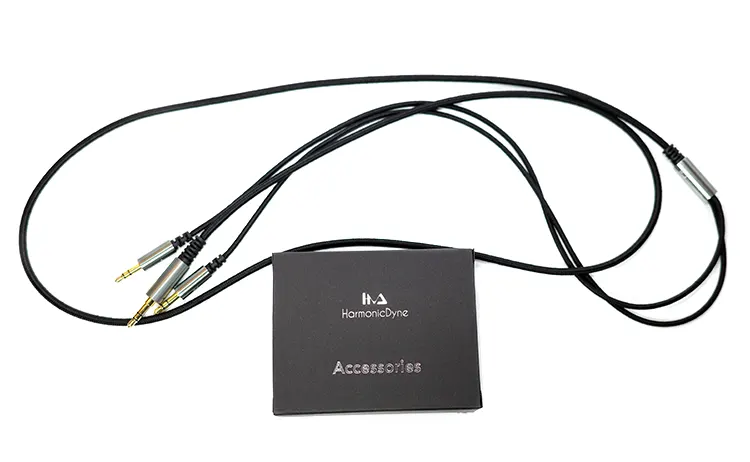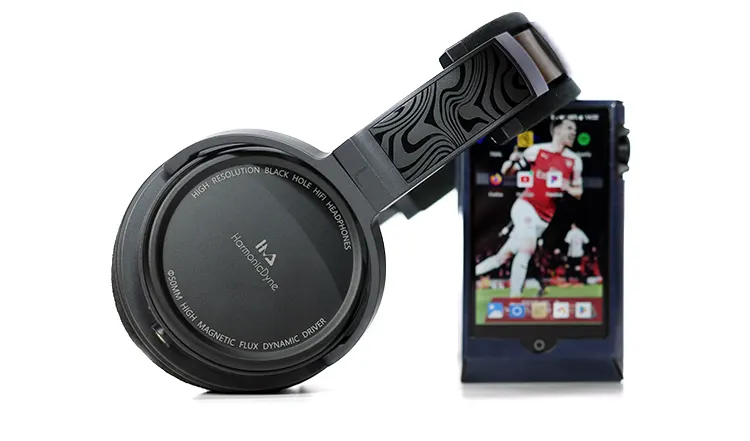Today, Lynn reviews the HarmonicDyne Black Hole, which is a set of affordable 50mm dynamic driver semi-open headphones with a strong focus on comfort. It is priced at $99.
Disclaimer: This sample was sent to me in exchange for my honest opinion. Headfonics is an independent website with no affiliate links or status. I thank Linsoul for this opportunity.
To read more about HarmonicDyne products previously covered on Headfonics please click here.
Note, that this article follows our latest scoring guidelines which you can read in more detail here.
It has now been more than two years since the boutique-styled headphones of HarmonicDyne first came out as a crowdfunded project.
Following the successful Zeus Elite and Athena models, HarmonicDyne has utilized that trickledown technology into a budget dynamic driver semi-open headphone called the Black Hole.
With the laudable goal of, “delivering better-sounding audio to the everyday music lover,” the focus in the Black Hole is to provide a Hi-Fi sound quality and ergonomic fit.
This is a very crowded market, and HarmonicDyne hopes to present an affordable option for those looking beyond the normally included headphones or Bluetooth models with a user’s Smartphone.
Tech Highlights
Running with the second generation 50mm driver consisting of a composite carbon fiber bio-film diaphragm, the Black Hole has an impedance of 32Ω @1KHz, and a sensitivity of 110dB/Vrms @1KHz.
This should make the Black Hole easy enough to drive while providing a good baseline for the sound signature.
Plenty of vents around the shelf of the Black Hole ear cup affords two benefits: one so that you can see through the unit if you desire, and two, giving the headphone room to stretch its legs as a semi-open back headphone.
Nothing earth-shattering, but somewhat novel enough to put this all together to form an audiophile-grade headphone.
Design
Using the second-generation M-Type pressure relief acoustic cavity, the Black Hole is a passive venting semi-open back headphone. This relieves internal pressures reducing sound reflections within the cup, purportedly for a cleaner and purer sound.
The Black Hole headband is designed to wrap around the user’s head and (potentially) better disperse the weight. A secure fit, with less clamping discomfort, is the result.
Unfortunately, that underpad is quite thin, and the felt (and limited padding) compresses readily, allowing the hard part of the headband to sit squarely on top of my cranial matter. The feel is lighter and a bit airier, which helps dissipate heat.
The Black Hole ear cup is made of aerospace aluminum alloy, treated to make it more durable. The majority of the rest is plastic, except for the pads. There is a nice glossy, topographic inlay on either side of the headband on the outside, giving some visual relief.
I believe the faceplate of the headphones is also an aluminum alloy, laden with the company name and various attributes describing the Black Hole.
The Black Hole aesthetic is that of a typical headphone, with subtle accents making it look a bit upscale without being garish or showy. The dual 3.5mm cable jacks will allow you to use your favorite balanced cable if you wish.
Comfort
The Black Hole velour earpads themselves are interchangeable using the tried and true sleeve into a groove behind the driver.
This makes for easy changing of pads to fit your listening style, and comfort. I did find that the grip on the stretchable material was too low, allowing the pads to shift around readily as a result.
This may not matter on most ear pads, but the unusual rectangular shape of the opening meant if they were askew from vertical, the sound did change, and you might hit parts of your ears on the edge of the cup material.
Detents inside the stanchions allow for a mostly personalized adjustment of the band and a good fit. Clamp pressure was a bit heavy on the lower side below my ear lobes, making it semi-comfortable for longer sessions.
Compression of the Black Hole ear pads was minimal, which may have hindered fit. Had they crushed a bit more, I believe the fit would have been a bit more plush. There also seemed to be a lack of internal padding, much like the underside of the headband.
Stock Cable
The 1.5-meter long Oxygen-Free Copper Cable with 3.5mm connectors allows for changing to your favorite balanced cable if you desire.
Microphonics was heard above the silver, logo-laden Y-Splitter on both sides. The synthetic fabric-covered housing makes for a nice use, with good laying of it; but I do wish for it to be a bit longer while using at my desktop.
There is no microphone/control button on the Black Hole’s stock cable, so this is only for audio purposes. Also included is a 6.35mm jack for use on other devices such as your two-channel setup.
Packaging & Accessories
Taking off the logo and information-laden sleeve first, you are met with a glossy plain black box, with only the “HarmonicDyne” in the lettering. Opening the box like you would rip the strip off a USPS mailing box was a different look than what I expected.
Once done, you lift the lid, clamshell-style to reveal the Black Hole tucked into a nicely set foam insert. The “accessories” box, which contains the cable, 6.35mm jack, and user manual are in a squarish box, inlaid across the headband for added protection, while holding its place.
A basic boxed effort, but with added protection, which is much appreciated.
Sound Impressions
Summary
The overall signature of the Black Hole is one of warmth and boomy bass overrides the details present; which is not bad for this level.
That depth of bass extends into the sub-bass region well, but without control. The boominess carries over into the mids, which are withdrawn, especially vocals, yet smooth and laidback; overshadowing them.
The upper end is rounded, without sparkle; making for a less than energetic treble region.
Bass
The Black Hole sub-bass is solid and thumping but at the expense of control and presence. That lack of control portrays itself as elongated notes in both attack and decay, without cohesiveness. This also lends itself to bleeding into the lower mids, which described below are fairly decent.
Bass quantity will appeal to those who like a robust low-end, such as the more popular brand marketed by many professional athletes. But the lack of control will not be desired by those who favor a more coherent signature, looking to fill a niche in their lineup.
Mind you, the Black Hole’s overall signature is appealing to those who like an energetic low-end, but the lack of accuracy overshadows this in my opinion.
Mids
The Black Hole lower mids come across as somewhat coherent, and more controlled than the low end, but are quickly overshadowed by the low-end bleed.
Vocals (4kHz-6kHz region) take a back seat to the lower mids, making for a withdrawn effect, playing behind instrumentation.
Recessed vocals turn into a bit of shoutiness in the upper mids, countering the relaxed upper end. While the overall character of the midrange is on the smoother side, the lack of definition into specific ranges overshadows what level of detail is present.
Those who prefer a smoothness to the mids may like this, for a lusher, thicker midrange, but do not expect the detail to come through as much.
Treble
The upper end lifts itself countering the recessed mids, trying to fill the gap that comes across. It does so with a smooth texture, that is not offending to me but lacks overall clarity and crispness.
The level of detail is best in this region, which does go a long way in settling the sound signature.
The good thing here is that the upper range will not come across as too spikey or sparkly, countering that spike in the mids. But if you prefer more clarity in the upper range, the Black Hole is lacking, much like getting sucked into a black hole, itself.
Staging
The height of the Black Hole soundstage makes for an expansive effect vertically, with an average width. But depth is lacking, countering this.
Due to that height, separation is good, allowing the listener to place instruments in the vertical plane well.
Left/right placing is adequate due to the width, but placing instruments on the stage fore and aft takes a backseat to the height and width. I think better depth would have helped to spread out the lower midrange lack of control while quelling the boominess down low.
If someone is looking for a headphone that accurately portrays the placement of instruments, the Black Hole will be adequate. This has the makings for a good companion on commutes or situations with a good amount of noise. Just do not expect too much accuracy while doing so.
Synergy
Efficiency
With an impedance of 32Ω @1KHz across 10-40KHz and a sensitivity of 110dB/Vrms @1KHz, the Black Hole is easy to drive and can attain loud listening levels quickly.
I could easily drive the Black Hole using my iPhone 13 Pro Max using the basic Apple dongle to loud enough levels, where I would have felt comfortable using the headphones on a commute or plane.
There is a bleed at those levels due to the semi-open design, which should be taken into consideration, though.
Pairings
Using the Black Hole connected to my Yamaha A-S301 and Sony PlayStation 1 (SCPH1001) for some recently acquired CDs, the sound was quite acceptable. I was also using the ddHiFi DJ65A as a dongle/adapter, which may have helped as well.
As mentioned, my iPhone 13 Pro Max worked for a decent enough combination when moving about, covering noises well.
The lack of detail from the Apple product did fall behind other pairings, but Tidal sounded good, nonetheless. This does make for a good pairing but do not expect it to be better than a dedicated DAP or two-channel system in most cases.
When paired with the Shanling M6 Pro, the sound was as good as the CD quality from the Yamaha/Sony mashup. Yes, the limitations of the Sony as a CD player can be haggled, but it did fit right into the level for the Black Hole.
Using Tidal and Qobuz on the M6 Pro, the Black Hole sounded vibrant and detailed, even with the warmer signature of the Shanling. I found myself raising the volume almost as much as on the other two sources but did not feel the need to so that I could attain good sound.

